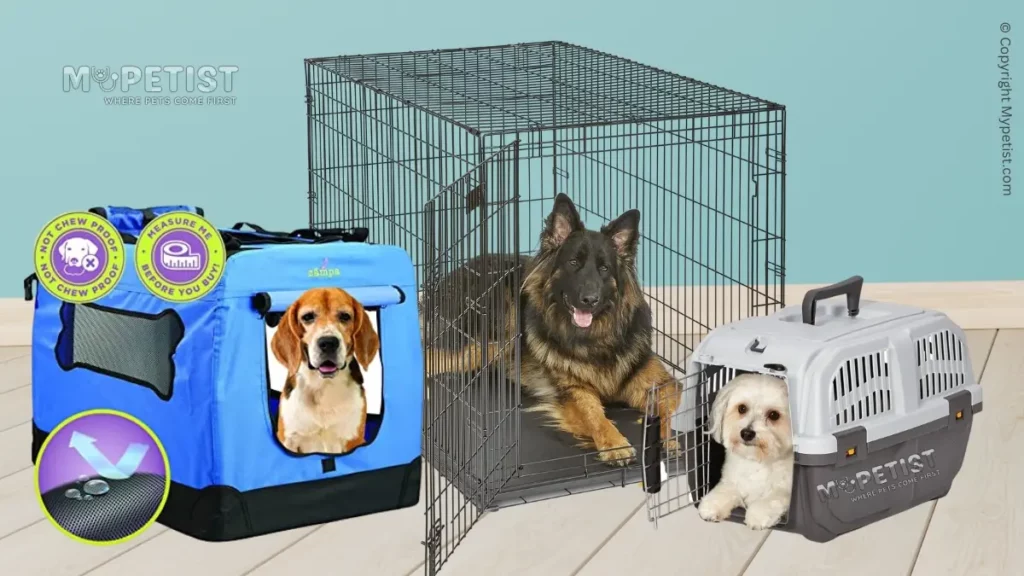How to Pick the Right Size Crate for Your Dog
When it comes to your furry friend, one of the items you will need to purchase is a crate. A dog crate provides a safe and comfortable space for your pup. However, choosing the right size crate for your dog is important for a number of reasons. In this article, we will explore why the correct crate size is important and how to choose the perfect crate for your pup.
Table of Contents
Why the Right Crate Size is Important for Your Dog?

Promotes Comfort and Safety
The right size crate should be large enough for your dog to stand, turn around, and lie down comfortably. A crate that is too small can make your dog feel uncomfortable and restrict his movements. On the other hand, a crate that is too large can make your dog feel insecure and unsettled.
Aids in Crate Training
Crate training is an important aspect of dog owning. A correctly sized crate can make the training process easier, and will also help prevent accidents, as dogs are unlikely to go potty in their sleeping quarters. By choosing the right size crate, you are helping your dog understand that the crate is a safe and comfortable space just for him.
Prevents Injuries and Anxiety
A crate that is too small can cause your dog injuries, as he may hit his head or get his paw caught in the wire. Furthermore, using a crate that is too big can make your dog anxious, as he may feel exposed and unprotected.
Key Factors to Choose the Best Dog Crate Size
The Size of Your Dog
The first and most important factor to consider when choosing a crate size is the size of your dog. Make sure to choose a crate that gives your furry friend plenty of space to stretch their legs, move around, and get cozy in their favorite sleeping positions. After all, they deserve to feel comfortable and at ease in their new home within your home! When measuring your dog, make sure to take into account his height and length, as well as his weight.
The Breed of Your Dog
The breed of your dog can also influence the size of the crate you choose. Larger breeds may require larger crates, while smaller breeds may do well in smaller crates. Additionally, some breeds may have special requirements for their crates, such as those with snub noses that may require ventilation holes.
The Type of Crate
The type of crate you choose also affects the size you need. For example, wire crates and plastic crates have different requirements. A wire crate requires more room, as your dog can see outside the crate and may feel unsettled if confined to a smaller space. A plastic crate, on the other hand, provides a sense of security and can be smaller.
How to Measure Your Dog for a Crate?
Measuring Your Dog’s Length
Measure your dog’s length from the tip of his nose to the base of his tail. Add two to four inches to this measurement to determine the minimum length of the crate.
Measuring Your Dog’s Height
Measure your dog’s height from the floor to the top of his head or ears. Add two to four inches to this measurement to determine the minimum height of the crate.
Measuring Your Dog’s Weight
While measuring your dog’s length and height is important, don’t forget to consider his weight too. A crate that is too small for your dog’s weight can be dangerous, especially if he is prone to chewing or clawing at his crate.
Choosing the Best Crate Size for Your Puppy
Using a Divider Panel
Puppies grow quickly and their crate requirements change, so consider purchasing a crate with a divider panel that can be adjusted as your puppy grows. This way, you can start with a smaller crate that fits your puppy’s current size, and expand the crate as they grow.
Considering Your Puppy’s Adult Size
When choosing a crate for a puppy, it’s important to consider their adult size. A puppy’s adult size can help you determine what size crate they will need in the long term, and you can plan ahead and purchase a crate that will fit their adult size requirements.
Allowing Room for Growth
When choosing a crate for your puppy, make sure to choose a crate that will accommodate his growth. A crate should be big enough to accommodate their growth, but not so big that it allows them to potty in one corner and sleep in another.
Different Types of Dog Crates and Their Sizes
Plastic Crate
A plastic crate provides your dog with a sense of security and privacy. When choosing a plastic crate, make sure it is big enough for your dog to stand up, turn around, and lie down comfortably, but not so big that they feel insecure. Plastic crates are easy to clean and travel-friendly.
Wire Crate
A wire crate provides your dog with plenty of ventilation and visibility. When choosing a wire crate, make sure it is big enough for your dog to stand up, turn around, and lie down comfortably. However, a wire crate should not be too big, as your dog may feel exposed and unsettled. Wire crates are also easy to clean and durable, making them a great choice for puppies who are still in their teething phase. Additionally, many wire crates come with a removable tray that makes cleaning up accidents or spills easy and convenient. However, wire crates can be noisy, especially if your dog is an active sleeper or likes to move around a lot.
They may also not be the best choice for dogs who prefer a cozy, enclosed space. In this case, a fabric or plastic crate may be a better option. When using a wire crate, it’s important to provide your dog with comfortable bedding and toys to make it feel like a cozy and welcoming space.
Besides, it’s essential to never leave your dog in a crate for an extended period of time, as this can cause stress and anxiety. Overall, a wire crate is a popular and practical choice for many pet owners. With proper sizing and a few added comforts, it can provide your dog with a safe and comfortable space to retreat to when needed.
Furniture-Style Dog Crate
Furniture-style dog crates are a great option if you want a crate that is both functional and beautiful. When choosing a furniture-style crate, make sure it is big enough for your dog to stand up, turn around, and lie down comfortably. Furniture-style crates can be made from a variety of materials, including wood, wicker, and metal.
Final Thoughts
Choosing the right size crate for your furry friend is essential. The crate should be comfortable and safe for your dog and should also make crate training a breeze. When choosing a crate size, take into account your dog’s size, breed, and type of crate. By choosing the right crate size, you will provide your dog with a sense of security and make him feel at home within the crate.




